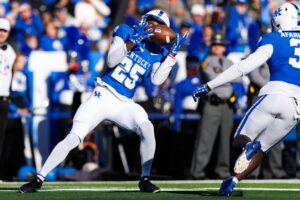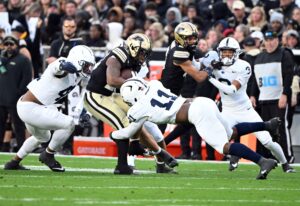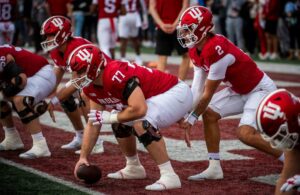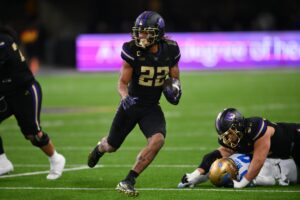It’s that time of year again. Except it’s 2020, which means that everything about this time of year–everything about this entire year– is different. And that includes the most constant thing in all of College Football: the annual Army-Navy Game. Yes, the global pandemic has even managed to alter one of the sport’s crown jewel events. These changes might be subtle, but they show just how different college football is this season. It might be the same game you’re familiar with, but it’s going to be totally different this year.
Army-Navy 2020: The Same Game in a Different Year
121st Army-Navy Game
Saturday, 3:00 ET, CBS
Army -7
At first glance, this might seem to be the most normal thing about this college football season. But there are some subtle differences about America’s Game this year. Some of these differences are superficial; some are not. Most of them speak to the overall health of the sport of college football, but some of them speak to the teams themselves. And like any true crisis, all of the differences speak to each of us in different ways.
The Location
For the first time in 77 years, one of the Service Academies will host the Army-Navy Game. Army’s Michie Stadium will host Army-Navy 2021, just as it did back in 1943. Since then, the annual rivalry is most closely associated with Philadelphia, both because of the geographic location generally between the two academies, it’s proximity to Washington, D.C.–where many Army and Navy graduates work, and because of the city’s unique station in our nation’s history.
But most importantly, Philadelphia, along with other host cities Baltimore, New York, and D.C. afford this game a venue and setting commensurate to its position in college football. With all due respect to The Game, The Iron Bowl, and all other great rivalries in college football, no other game means as much to the teams, institutions, and fans of the contestants than Army-Navy. It’s no exaggeration to say that almost every single Cadet and Midshipman utter the words “Beat Navy” or “Beat Army” on almost every single day at their respective schools. This one game far outweighs any other contest for either of these non-Power 5 programs. But for one game a year, they normally get a venue of NFL prominence to stage one of the great scenes in college sports.


Staying At Home
Not this year. With the COVID-19 pandemic continuing to cause serious public health concerns and the inevitable political chaos, Army and Navy had to pull back from their normal Broad Street venue. Instead of a capacity crowd of 70,000, they will settle for an almost empty Michie Stadium nestled in the picturesque Hudson Highlands.
Army-Navy 2020 is pulling back from a national venue, with its big-city vibe and NFL-like accommodations to, essentially, “stay at home” for the big game. That’s as 2020 as you can get. It won’t look or feel much different watching it on T.V. Those networks are darn good at what they do. But like everything else about the 2020 college football season, it’ll simply be a mirage of normalcy in a sea of uncertainty.
The Teams
Nothing harkens back to the good old days like watching Army and Navy’s modern variant of the triple-option offense. It’s simply the best way that these teams can compete given some of the unique limitations on their student-athletes. These teams have, however, taken different paths to get here this year.
Navy
Navy Head Coach Ken Niumatalolo took a very conservative approach to prepare his team for the 2020 season. The Midshipman prioritized health measures and utilized a no-contact fall camp. It showed as the Midshipman were out-scored in their first three games 119-37, with blow-out losses to BYU and Air Force. After recovering in the middle of the season with wins over Temple and East Carolina, Navy brings a four-game losing skid into Saturday’s contest. Niumatalolo also made comments critical to the efforts to ensure the Army-Navy game moved forward this year, causing a stir in the close-knit Service Academy community. As another indicator of how different this game is this year, never in the history of this rivalry has a coach questioned the efficacy of playing this game. It was an alarming example of how different Niumatalolo and his Navy program have approached this season. To be clear, Niumatalolo has prioritized the health of his players above all else. That’s certainly a position hard to argue against.
Navy’s Struggling Offense
Navy comes into this game with questions on both sides of the ball. The Midshipman are averaging 185.3 rushing yards per game this season. That’s down from a five-year average of 325.04 per game. The Midshipmen have finished first, fifth, second, fourth, and second in the nation in rushing yards per game over the last five seasons. They are currently 46th in the nation.
Navy has rotated through three primary signal-callers this season. None of those have put up the usual rushing numbers from that position. Freshman Xavier Arline is expected to make the start on Saturday.
Running backs Nelson Smith and Jamale Carothers have carried the load for the Mids from the fullback position. Those two players alone account for 59% of the Navy rushing total this season.
The Navy offense needs to improve on their paltry 18.4 points per game production to make it two in a row over Army. The Midshipman have put up 13 points total in the two weeks in losses to Memphis (10-7) and Tulsa (19-6).
Navy’s Improving Defense
On the other hand, Navy’s defense has shown improvement throughout the season. After giving up 119 points in the first three games, including an embarrassing defensive performance against BYU, the Mid’s defense has allowed 23 or fewer points in three of their last five games. Navy is allowing 212.56 yards of rushing offense to opponents this season, which is obviously concerning going into a game against Army. However, since both schools run almost identical offenses, the Midshipmen should be in a good position to counter the potent Army rushing attack.
Much of their success will rely on linebackers Diego Fagot and John Marshall. Their ability to limit Army’s interior rushing attack is the key to a Navy win.
Army
Army’s Jeff Monken took a different tack with his team this season. While Army had to completely re-tool their schedule amidst the chaotic season. But even so, Monken and Army went full steam ahead in 2020. That was partly because they wanted to get the bad taste of 2019 out of the program, and partly because that’s just how Monken is wired. A coach’s coach from a coaching family, Monken is Academy football personified.
Army’s Inconsistent Offense
Army has put up strong numbers this season. The Black Knights are currently third in the nation in rushing offense per game, with 296.67 yards per game. But the offense has been inconsistent throughout the season. Like Navy, Army has shuffled signal-callers with four different quarterbacks seeing significant action this season. This quarterback shuffle has led to Army’s highest amount of penalties per game (5.1) in 11 years. Army has also had issues with turnovers this season, holding a slim 14-12 turnover margin edge. For Army to beat Navy, the quarterback play must be steady.
Sophomore Tyhier Tyler will lead the Army offense on Saturday. Tyler notched his first 100-yard rushing game in a win over Georgia Southern three weeks ago. Unlike Navy, Army will rely on an entire backfield of ball carriers. It takes five Army rushers to get to Nelson and Carothers’ 59% workload. In addition to Tyler, fullbacks Sandon McCoy and Jakobi Buchanan and A-back Tyrell Robinson will lead the Army ground game.
Army Building Momentum
The Black Knights started the season strong, outscoring MTSU and Louisiana-Monroe 79-7. They’ve been largely inconsistent since Week 2. In addition to penalties and turnovers, a constantly changing schedule has contributed to that inconsistency. Entering this Saturday’s game, only one of Army’s previous nine opponents were on their original 2020 schedule. Such is life for an independent in the 2020 season.
They’ve struggled to translate dominating rushing performances and time of possession into decisive victories. The Black Knights will look to build and maintain momentum from their rushing attack on Saturday. If so, they will add a fourth Army-Navy win in five years and are already slated for a fourth bowl game in five years. Monken is quietly building the best era of Army football since Red Blaik’s 18-year tenure ended in 1958.
The Bigger Picture
There’s a bigger picture with Army-Navy 2020, as there always is in this game. Every sports fan is familiar, at least at some level, with how this game is different. From the pageantry to the demands on the student-athletes, to the President’s attendance, the special meaning of this game will be clearly evident again this year. It’ll be the same game where fans can sneak a peek into the way football was played in the days before $300 million dollar TV deals and pass-happy offenses. But there’s also some different context around the game this year as well.
The Pandemic Context
Obviously, nothing in 2020 can be discussed outside of the global COVID-19 pandemic context. As mentioned earlier, Navy and Ken Niumatalolo took a very conservative approach to this season amid the pandemic and its required protocols. Army, on the other hand, was very aggressive in their approach to this season. Neither approach was necessarily better or worse than the other. And it seems that both approaches worked as desired.
The difference about this season is how different the two programs arrived at this point. As homogenous as the sport of college football is, no two programs are as much alike as Army and Navy. They are almost always in lockstep with big decisions that affect Academy football. Normally, nothing separates these teams other than this game. Not war nor riches. But the pandemic did what war couldn’t, and that shouldn’t be lost on anyone watching on Saturday.
The Social Context
The Pandemic isn’t the only thing affecting sports these days. So, too, has the growing consciousness of social and political issues. Army-Navy 2020 provides one of those unique opportunities in sports where you can both use sport as an escape and simultaneously see a path to improvement within our society. These players, playing a child’s game, represent institutions that certainly aren’t perfect, but represent the best of what our people can become. You can enjoy some high quality, historically meaningful football, and feel good about things all at the same time. And that, unfortunately, is rare these days.
The Stage
Unfortunately, this confluence of sports and culture is up against yet another obstacle this year: the rest of college football. Army-Navy normally enjoys a national spotlight as the penultimate act to college football’s regular season. Not this year. Army-Navy will be competing against every major conference on Saturday. The game will be opposite of nine other games in the mid-afternoon time slot, with four Top 25 teams in action during that time.
We’ll see how truly meaningful the Army-Navy rivalry is to the sport of college football on Saturday. If there’s anything that the global pandemic and social awareness have taught us, it’s to appreciate the simple and genuine in life. To focus on the basics. And the value of some of the basic tenets of life – honesty, compassion, and appreciation. Nowhere in college football are these tenets more evident than at an Army-Navy game.
The year is different, but the game remains the same.






